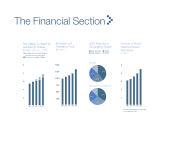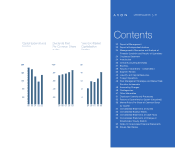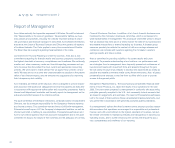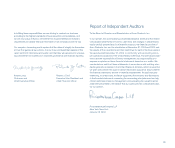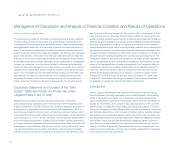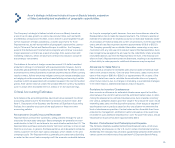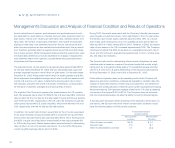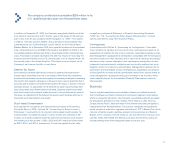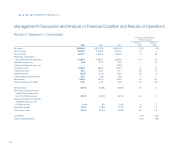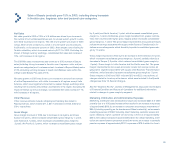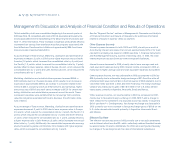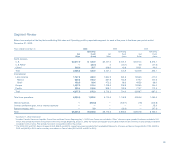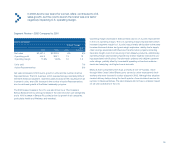Avon 2003 Annual Report Download - page 7
Download and view the complete annual report
Please find page 7 of the 2003 Avon annual report below. You can navigate through the pages in the report by either clicking on the pages listed below, or by using the keyword search tool below to find specific information within the annual report.
Management’s Discussion and Analysis of Financial Condition and Results of Operations
management’s discussion
Avon’s calculations of pension, postretirement and postemployment costs
are dependent on assumptions, including discount rates, expected return on
plan assets, interest cost, health care cost trend rates, benefits earned, mor-
tality rates, the number of associate retirements, the number of associates
electing to take lump-sum payments and other factors. Actual results that
differ from assumptions are accumulated and amortized over future periods
and, therefore, generally affect recognized expense and the recorded obliga-
tion in future periods. While management believes that the assumptions used
are reasonable, differences in actual experience or changes in assumptions
may materially affect Avon’s pension, postretirement and postemployment
obligations and future expense.
The expected return on plan assets for all pension plans approximated $75.0
for the year ended December 31, 2003, and was calculated based upon the
average expected long-term rate of return on plan assets. For the year ended
December 31, 2003, the assumed rate of return on assets globally was 8.3%,
which represents the weighted-average rate of return on all plan assets includ-
ing the U.S. and non-U.S. plans. In determining the long-term rate of return,
the Company considers the nature of the plans’ investments, an expectation
for the plans’ investment strategies and historical rates of return.
The majority of the Company’s pension plan assets relate to the U.S. pension
plan. The assumed rate of return for 2003 for the U.S. plan was 8.8%. Historical
rates of return for the U.S. plan for the most recent 10-year and 20-year periods
were 7.8% and 10.5%, respectively. In the U.S. plan, the Company’s asset allo-
cation policy has favored U.S. equity securities, which have returned 10% and
12%, respectively, over the 10-year and 20-year periods.
In addition, the current rate of return assumption for the U.S. plan was based
on an asset allocation of approximately 35% in corporate and government
bonds (which are expected to earn approximately 5% to 7% in the long term)
and 65% in equity securities (which are expected to earn approximately 9%
to 10% in the long term). Similar assessments were performed in determining
rates of return on non-U.S. pension plan assets, to arrive at the Company’s
current weighted-average rate of return of 8.3%.
During 2002, the assets associated with the Company’s benefit plans experi-
enced negative investment returns, most significantly in the U.S. plan where
the market value of plan assets declined approximately 13%. As a result,
Avon made cash contributions to its U.S. qualified pension plan of $60.0 in
2003 and $120.0 in 2002 versus $25.0 in 2001. However, in 2003, the market
value of plan assets in the U.S. increased approximately 20%. The Company
continues to believe that 8.3% for all plans is a reasonable long-term rate of
return and will continue to evaluate the expected rate of return, at least annu-
ally, and adjust as necessary.
The discount rate used for determining future pension obligations for each
individual plan is based on a review of long-term bonds that receive a high
rating given by a recognized rating agency. The weighted average discount
rate for U.S. and non-U.S. plans determined on this basis has decreased to
6.0% at December 31, 2003, from 6.3% at December 31, 2002.
Future effects of pension plans on the operating results of the Company will
depend on economic conditions, employee demographics, mortality rates, the
number of associates electing to take lump-sum payments, investment per-
formance and funding decisions. However, given current assumptions (including
those noted above), 2004 pension expense related to the U.S. plan is expected
to increase in the range of $10.0 to $15.0. The Company does not anticipate
that this incremental expense will affect its ability to meet its financial targets.
A 50 basis point change (in either direction) on the expected rate of return on
plan assets, the discount rate or the rate of compensation increases would
have the following effect on 2003 pension expense:
Increase/(Decrease) in
pension expense
50 basis point 50 basis point
Increase Decrease
Rate of return on assets $(4.4) $ 4.4
Discount rate (7.7) 8.7
Rate of compensation increase 4.1 (3.4)
26

